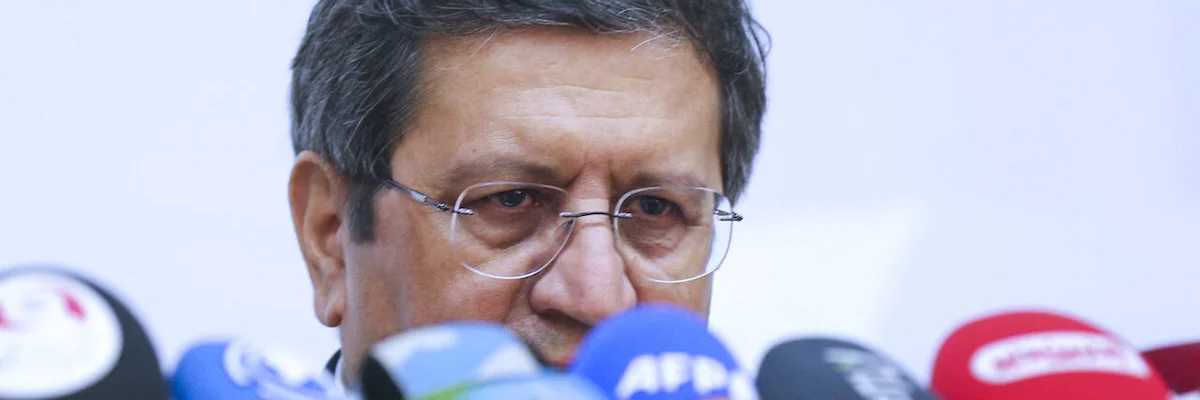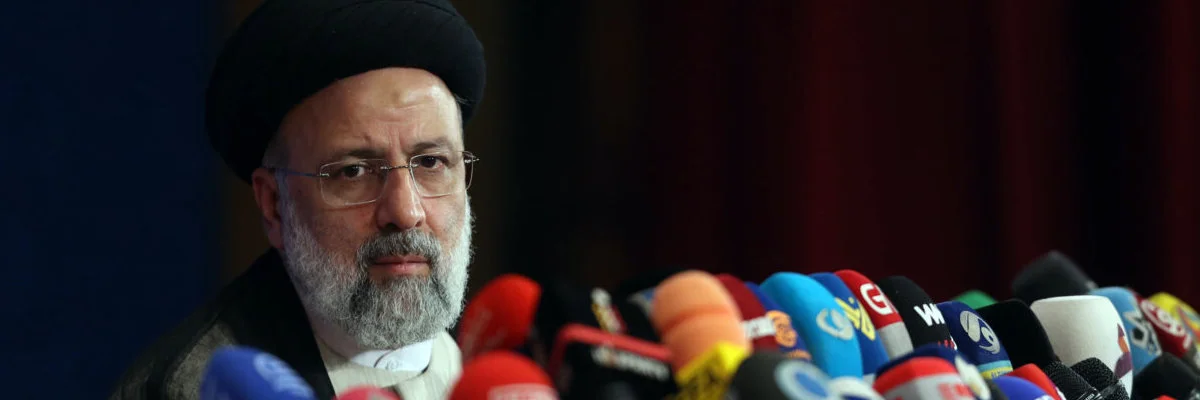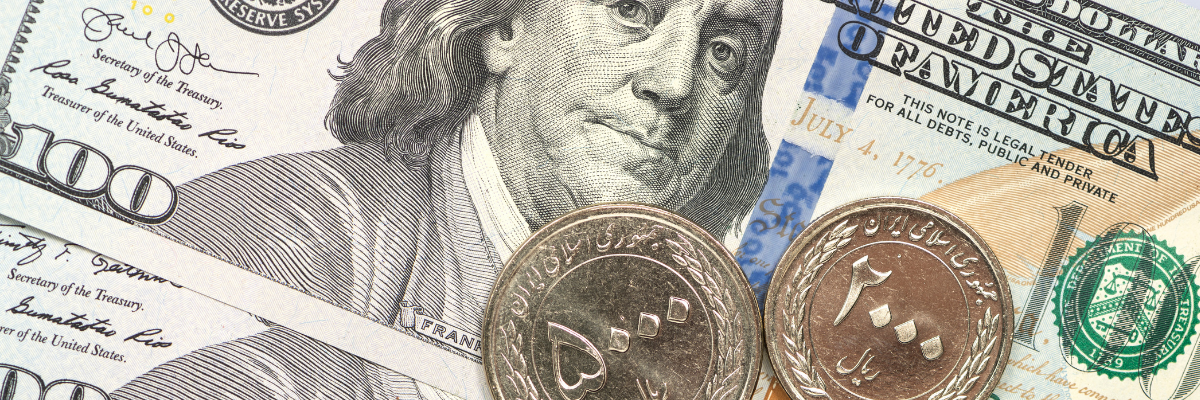Did Presidential Hopeful Hemmati Successfully Defend Iran's Currency?
Iran’s economic stagnation and widening inequality are top concerns for Iranian voters ahead of the presidential election on Friday. It is therefore no surprise that during three televised debates, candidates ganged up on Abdolnasser Hemmati, until recently Iran’s central bank governor. Frontrunner and head of the judiciary Ebrahim Raisi railed against Hemmati, promising voters that he would reduce the impact of exchange rates on prices, succeeding where Hemmati failed. Former IRGC officer Mohsen Rezaei claimed that Iran’s currency had lost so much value under Hemmati’s watch “the train of the revolution has turned into a scooter.”
It is true that Iran’s currency suffered a steep devaluation while Hemmati was central bank governor, but the attacks from the likes of Raisi and Rezaei are spurred not by the failure, but rather the demonstrable success of Hemmati’s management of Iran’s economic crisis. At least in the narrow area of currency policy, Hemmati made considerable progress in returning stability to foreign exchange markets at each point of crisis, meanwhile reducing the ability for special interests to profit from Iran’s system of multiple exchange rates.
When Hemmati was appointed governor of the Central Bank of Iran in July 2018, Iran’s currency had already begun to lose value. Beginning in April 2018, Iran’s currency markets responded to the news that the Trump administration was to reimpose secondary sanctions on the country. The accelerating currency crisis would be the first test of a platform the Central Bank of Iran had introduced earlier that year—a new Integrated Foreign Currency Trading System, known by its Persian acronym “NIMA.”
NIMA is part of Iran’s Comprehensive Trade Platform (NTSW), a set of registries and systems that enable companies to receive licenses to conduct certain kinds of trade and to purchase and sell foreign exchange as part of that trade. NIMA is paired with another platform called “SANA,” the Persian acronym for Foreign Currency Control System. The main difference between these two platforms is that NIMA is for international transactions with importers and exporters, while SANA is for transactions of foreign currency within the country, for instance between exchange bureaus.
Using NIMA companies no longer needed to seek allocations of foreign exchange from the Central Bank of Iran or commercial banks, a system that disadvantaged companies with less established banking relationships and less political clout. All importers and exporters are required to use NIMA.
The implementation of NIMA was slow and Hemmati, coming into office at a moment of crisis, struggled to get companies to use the new platform. By September 2018, the price of the dollar had reached a historic high of IRR 170,000 as supply-side pressure grew in advance of the full reimposition of secondary sanctions in November 2018. Imported intermediate and finished goods grew more expensive as suppliers dropped out of the market. At the same time, the Iranian financial system faced reduced liquidity in key currencies such as the Euro. As foreign exchange revenues declined, the central bank was unable to tap into foreign reserves. The Trump administration moved aggressively to freeze these reserves, even for use in humanitarian trade, leading just 10 percent of Iran’s overall reserves freely accessible by the end of 2019. To address these pressures, Hemmati sought to ensure that Iranian companies earning foreign currency made that currency available for sale through NIMA.
As per the guidelines issued by the central bank in November 2018, all exporters have a “foreign currency repatriation obligation.” According to these regulations, companies earning more than EUR 10 million a year in export revenue are obligated to repatriate 90 percent of those earnings through NIMA.
At first, adherence to the guidelines was disappointing. Hemmati publicly criticised large exporters, particularly petrochemical companies, that were failing to repatriate revenues. These companies were delaying in order to profit in rial terms as the currency continued its slide. In February 2019, CBI made a further announcement and instituted an incentive package, in which the exporters were categorised based on their performance in complying with the rules set in the market. Exporters with higher compliance—those who repatriated funds most reliably—would benefit from lower obligations for supply of foreign currency in NIMA.
Over time, the public pressure and improved incentives led to greater uptake of the NIMA system. The electronic platform significantly increased transparency in Iran’s foreign exchange market. The earnings of exporters are linked to their export licenses, exchange bureaus bought foreign currency according to offers in which the currency, exchange rate, total value, and origin of funds are all known. Importers register their offers to buy foreign currency from exchange bureaus. Each transaction is duly recorded in NIMA.
Hemmati claimed moderate success by March 2019, noting that $19 billion of export revenue had been repatriated via the NIMA system. This was still just a fraction of Iran’s overall export revenue. But the impact of the foreign exchange market was noticeable. When combined with the economy’s structural adjustments to the reimposition of sanctions, the currency policy instituted by Hemmati saw the value of the currency remain below the September 2018 peak for the duration of the next year. A steady decline in the price of the dollar began in May 2019, at which point the price reached IRR 160,000 following the Trump administration’s revocation of waivers permitting Iran to export limited volumes of oil. By the end of 2019 the dollar price was around IRR 130,000.
In the first quarter of 2020, Iran’s economy faced a new shock—the pandemic. The impact of the pandemic was in many respects similar to the impact of sanctions—supply chain disruptions made imported goods more expensive. But at the same time, Iran’s non-oil exports fell due to the impact of lockdowns on production, logistical constraints, and reduced demand, particularly in regional markets. Iran was facing an acute balance of payments crisis. The value of the rial began to slide in earnest around February 2020, when the pandemic hit Iran. The value of the dollar peaked in October 2020 at IRR 330,000, an increase that had contributed to high rates of inflation. The situation may have been worse had NIMA not been in place. During the Iranian calendar year ending March 2021, Iranian exporters repatriated 72 percent of their foreign exchange earnings, around $52 billion.
After the dollar hit its peak price in October 2020, the rial recovered value quickly because of two factors. Iran’s economic recovery was picking-up steam. Greater oil exports to China and greater regional demand for non-oil goods had buoyed export revenue. Iran’s economic was actually returning to growth. Meanwhile, in Washington, the re-election prospects for Donald Trump were fading, and the notion that Iran could once again benefit from sanctions relief reduced demand for foreign currency, especially among ordinary Iranians who frequent exchange bureaus and purchase dollars and euros as a hedge against inflation.
Iran’s currency has been remarkably stable since October and in another indication of the success of the NIMA platform, the spread between the free market rate and the NIMA rate has been reduced significantly. Combined with a reduction in the number of goods eligible for the subsidised exchange rate of IRR 42,000, this has resulted in a de facto unification of Iran’s three-tiered exchange rate system. Given that one of the largest sources of corruption in the country has been the arbitrage between these rates, including situations in which companies would receive fraudulent allocations of foreign currency at the subsidised rate only to turn around and sell that currency at the free market rate, Hemmati’s interventions can be said to have had a significant impact on corruption—a point he alluded to during the debates.
To understand Hemmati’s impact, it is perhaps best to compare the case of Iran with that of Turkey or Lebanon, two countries where the devaluation of national currencies is continuing unabated, precisely because leaders at the central bank lack the means or the might to arrest the decline. Hemmati saw that the train of the revolution was at risk of careening into the abyss and at least he sought to keep it on track. His opponents may not prove so adept.
Photo: IRNA




